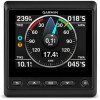Garmin GMI 20 Owner s Manual - Page 7
Display Settings, Alarm Settings, Viewing NMEA 2000 Settings, NMEA 2000 Data Type Information, - installation
 |
View all Garmin GMI 20 manuals
Add to My Manuals
Save this manual to your list of manuals |
Page 7 highlights
Configuring the Position Format NOTE: Do not change the position format or the map datum unless you are using a map or chart that specifies a different position format. Position Format sets the position format in which a given location reading appears. Map Datum sets the coordinate system on which the map is structured. 1 Select > Setup > System > Position. 2 Select an option: • To change the position format in which a reading appears, select Position Format. • To change the coordinate system on which the map is structured, select Map Datum. Restoring System Settings to Factory Default You can restore factory default settings for all system settings. 1 Select > Setup > System > Factory Defaults. 2 Select Yes. Display Settings Select > Setup > Display. Color Mode: Sets the device to display day or night colors. Configure Colors: Sets the color configuration for each color mode. For day color mode, you can select a full color or high contrast color configuration. For night color mode, you can select a full color, red and black, or green and black color configuration. Backlight: Sets the backlight brightness. Network Sharing: Shares color mode, color configuration, and backlight settings with devices across the NMEA 2000 network. Total Rode Onboard: Sets an alarm to sound when the length of rode deployed from the boat reaches a specified length. Anchor Docking Dist. : Sets an alarm to sound when the length of rode deployed is less than the specified length. Viewing NMEA 2000 Settings You can view information about NMEA 2000 devices and change available device-specific options. 1 Select > Setup > NMEA 2000 Devices. 2 Select an option: • To view information about the device, such as the software version and the serial number, select Device List. • To change the label of a device, select Label Devices. NMEA 2000 Data Type Information Each NMEA 2000 certified sensor provides unique information to the NMEA 2000 certified display device, such as the GMI 20. The data you can view on your display depends on the sensors you have installed and configured. See the General NMEA 2000 Data Type Requirements topic in the Technical Reference for Garmin NMEA 2000 Products manual at www.garmin.com / support. Registering Your Device Help us better support you by completing our online registration today. • Go to http: / / my .garmin .com. • Keep the original sales receipt, or a photocopy, in a safe place. Alarm Settings Select > System > Alarms. Shallow Water: Sets an alarm to sound when the depth is less than the specified value. Deep Water: Sets an alarm to sound when the depth is greater than the specified value. Surface Temperature: Sets an alarm to sound when the transducer reports a temperature that is 1. 1°C (2°F) above or below the specified temperature. Total Fuel Onboard: Sets an alarm to sound when the fuel remaining (based on fuel-flow information from a fuel sensor) reaches the specified level. Engine Status: Sets an alarm to sound when an engine indicates there is a problem. Apparent Wind Speed: Sets an alarm to sound when the apparent wind speed is at, above, or below the specified speed. True Wind Speed: Sets an alarm to sound when the true wind speed is at, above, or below the specified speed. Apparent Wind Angle: Sets an alarm to sound when the apparent wind angle is at, greater than, or less than the specified angle. True Wind Angle: Sets an alarm to sound when the true wind angle is at, greater than, or less than the specified angle. Unit Voltage: Sets an alarm to sound when the battery voltage reaches the specified level. Anchor Drag: Sets an alarm to sound if the boat moves a specified distance away from the point at which the GPS received the coordinates from where the anchor was dropped. Device Configuration 3













